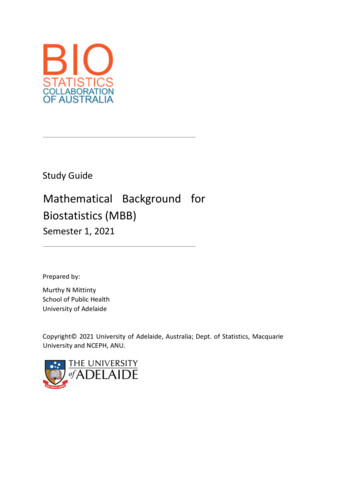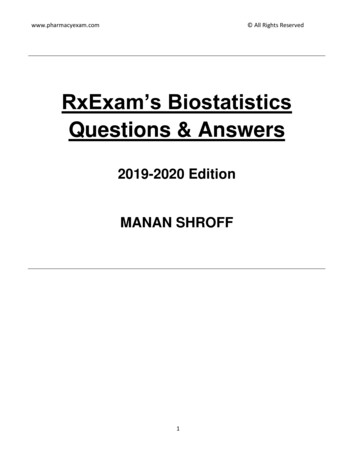
Transcription
www.pharmacyexam.com All Rights ReservedRxExam’s BiostatisticsQuestions & Answers2019-2020 EditionMANAN SHROFF1
www.pharmacyexam.com All Rights ReservedThis book is not intended as a substitute for the advice of physicians. Students or readers must consult theirphysician about any existing problem. Do not use information in this book for any kind of self-treatment. Donot administer any dose of mentioned drugs in this book without consulting your physician.The author is not responsible for any kind of misinterpreted, incorrect, or misleading information or anytypographical errors in this book. Any doubtful or questionable answers should be checked in otheravailable reference sources.All rights reserved.No part of this book may be reproduced or transmitted in any form or by any means, electronicallyPhotocopying, recording, or otherwise, without prior written permission of the publisher.RXEXAM is a registered trademark of Pharmacy Exam of Krishna Publications Inc. Any unauthorized use ofthis trade mark will be considered a violation of law.2
www.pharmacyexam.com All Rights Reserved1. In biostatistics, confounding is normally definedas:5. The scores of Naplex for 10 students are 75, 82,90, 92, 67, 95, 110, 80, 82, 86. Find the mean for theabove data.a. One chosen from a carefully defined populationwith the aid of a formal method to avoid bias.a. 83.6b. 85.9c. 836d. 43b. A formal method to assign subjects by chance toone or the other treatment.c. The effect of two or more variables that do notallow a conclusion about either one separately.6. The scores of Naplex for 10 students are 75, 82,90, 92, 67, 95, 110, 80, 82, 86. Find the median forthe above data.d. The systematic tendency of any factorsassociated with the design, conduct, analysis, andevaluation of the results of a trial to make theestimate of a treatment effect deviate from its truevalue.a. 110b. 84c. 82d. 672. The data that categories patients as males orfemales are known as:7. The scores of Naplex for 10 students are 75, 82,90, 92, 67, 95, 110, 80, 82, 86. Find the mode forthe above data.a. Random datab. Nominal datac. Ordinal datad. Interval dataa. 75b. 90c. 86d. 823. Which of the following data represents intervalcontinuous data?8. Classifying continuing educational experienceinto categories including “strongly agree,”“agree,”and “disagree,” is an example of which type ofvariable or data?a. A number of cigarettes smoked per day by aperson.b. A number of children in a household.c. Height of children.d. Number of languages a person speaks.a. Nominalb. Ordinalc. Intervald. Ratio4. Data can be transformed by using the logarithm,square root, or reciprocal. Which of the following isthe most common data transformation used inmedical research?9. Which of the following statements about theprevalence is/are TRUE?a. data converted to logb. data converted to rootc. data converted to reciprocald. data converted to ratioI. It is a measure of the rate of occurrence of acondition.II. It is the number of new cases of a condition thatdevelop during a specific period of time.III. It is the proportion of a population found to havea condition at a single point in time.3
www.pharmacyexam.com All Rights Reserveda. I onlyb. III onlyc. II and III onlyd. Allc. the risk of heart failure in patients taking thestudy drug was more than the risk of heart failure inpatients taking placebo.14. What is the value of relative risk reduction if anRR is 0.33?10. “One out of every 50 adults in the United Stateshas depression.” This statement is an example of:a. 1.56b. 0.33c. 0.67d. 1.33a. Incidenceb. Prevalence11. Which of the following statements best describethe relative risk (RR)?15. What would be the absolute risk reduction if theincidence of heart attack was 2% in the interventiongroup and 7% in the control group?a. It is the risk of an event or outcome occurring in agroup of interest in relation to a control group.a. 15%b. 5%c. 2%d. 7%b. It usually states how much the treatmentreduced the risk of an outcome relative to thecontrol group.c. It represents the absolute difference of the eventrate between the treatment and control groups.16. If the calculated absolute risk reduction (ARR)for heart attack event was 5.1%, what would be thenumber needed to treat?d. It is a representation of the number of patientswho need to be treated to prevent one additionalevent compared to treating the same number ofpatients with the control therapy.a. 11b. 2.65c. 3.2d. 2012. Calculate the value of RR if the risk of heartfailure associated with an invention drug is 5%versus 9% with placebo?17. Which of the following statements is TRUEABOUT the standard deviation (SD)?a. 1.25b. 2.65c. 0.55d. 1.8a. It is used to calculate confidence intervals.13. Which of the following statements best describethe interpretation of value of RR obtained in aprevious question?c. It is used to display bimodal or skewed data.b. It is used to determine variability of a samplearound a sample mean.d. A large SD shows that individual data points areclustered closer to the mean.a. there was no association between the study drugand heart failure.18. If the sample size in a study is 100 subjects andthe SD for blood glucose is 10 mg/dl, what is thestandard error of the mean?b. the risk of heart failure in patients taking thestudy drug was less than the risk of heart failure inpatients taking placebo.a. 65.94
www.pharmacyexam.com All Rights Reservedd. the regression model explained 30% of the totalvariance is not a good fit.b. Employees who exposed to asbestos for morethan 10 years had 16% decreased odds ofdeveloping asthma than those who did not.146. In a study examining the relationship betweenthe drinking a coffee in the late evening and thelikelihood of insomnia, the r2 value for theregression line is 1.0. What does this indicate?c. The results are not significant because theconfidence interval includes 1.0.d. The results are not significant because theconfidence interval is greater than 1.0.a. For each additional cup of coffee, chances ofoccuring insomnia increase by 1.0%.149. What does “OR 0.4 95%CI 0.4-0.6 p 0.05”mean?2b. Since r equals 1.0, this indicates there is norelationship between drinking coffee anddeveloping insomnia.a. The odds of death in the intervention groups are60% less than the odds of death in the controlgroups with the true population effect between60% and 40%.This result was statisticallysignificant.c. Since r2 equals 1.0, the regression line perfectlyfits the data.d. For each additional cup of coffee, there is noeffect on sleep.b. The odds of death in the intervention groups are60% more than the odds of death in the controlgroups with the true population effect between60% and 40%.This result was statisticallysignificant.147. Which of the following information is/are TRUEABOUT an odds ratio (OR)?I. If the OR 1 indicates there is no differencebetween the two arms of the study.c. The odds of death in the intervention groups are60% less than the odds of death in the controlgroups with the true population effect between40% and 60%. This result was statistically NOTsignificant.II. If the OR is 1 the control is better than theintervention.III. If the OR is 1 the intervention is better than thecontrol.d. The odds of death in the intervention groups are60% more than the odds of death in the controlgroups with the true population effect between40% and 60%. This result was statistically NOTsignificant.a. I onlyb. I and II onlyc. II and III onlyd. All150. A drug company-funded double blindrandomised controlled trial evaluated the efficacyof an adenosine receptor antagonist Cangrelor vsClopidogrel in patients undergoing urgent orelective Percutaneous Coronary Intervention (PCI)who were followed up for specific complications for48 hrs (Bhatt et al. 2009). The results sectionreported “OR 0.65 95% confidence interval [CI],0.55 to 0.83; P 0.005” What does this mean?148. Suppose a study examined the relationshipbetween workers exposed to an asbestos for morethan 10 years and the risk of developing asthma. Ifthe study found an increased risk of asthma in thegroup who exposed to asbestos (OR: 1.16, 95% CI:0.9-1.5). What does this mean?a. Employees who exposed to asbestos for morethan 10 years were 1.16 times less likely to developasthma than those who did not.21
www.pharmacyexam.com All Rights Reserveda. The odds of death, myocardial tthrombosis at 48 hours after randomization in theCangrelor arm were 35% less than in theClopidogrel arm with the true population effectbetween 34% and 7%. This result was notstatistically significant.b. The odds of death, myocardial tthrombosis at 48 hours after randomization in theCangrelor arm were 35% less than in theClopidogrel arm with the true population effectbetween 45% and 17%. This result was statisticallysignificant.c. The odds of death, myocardial tthrombosis at 48 hours after randomization in theCangrelor arm were 35% less than in theClopidogrel arm with the true population effectbetween 45% and 17%. This result was statisticallyNOT significant.d. The odds of death, myocardial tthrombosis at 48 hours after randomization in theCangrelor arm were 35% less than in theClopidogrel arm with the true population effectbetween 34% and 7%. This result was statisticallysignificant.22
www.pharmacyexam.com All Rights ReservedBiostatistics Answers1. (c) The effect of two or more variables that donot allow a conclusion about either one separatelyis defined as confounding.“names” or categories based on the presence orabsence of certain attributes/characteristicswithout any ranking between the categories. Forexample, patients are categorized by gender asmales or females; by religion as Hindu, Muslim, orChristian. It also includes binominal data, whichrefers to two possible outcomes. For example,outcome of cancer may be death or survival, drugtherapy with drug ‘X’ will show improvement or noimprovement at all.Random sample: one chosen from a carefullydefined population with the aid of a formal methodto avoid bias and confounding.Randomization: in comparative trials, a formalmethod to assign subjects by chance to one or theother treatment.2. Ordinal data: It is also called as ordered,categorical, or graded data. Generally, this type ofdata is expressed as scores or ranks. There is anatural order among categories, and they can beranked or arranged in order. For example, painassociated with cancer may be classified as mild,moderate, and severe. Since there is an orderbetween the three grades of pain, this type of datais called as ordinal. To indicate the intensity of pain,it may also be expressed as scores (mild 1,moderate 2, severe 3). Hence, data can bearranged in an order and rank.Random errors: errors that follow the principle ofindifference.Bias: The systematic tendency of any factorsassociated with the design, conduct, analysis, andevaluation of the results of a trial to make theestimate of a treatment effect deviate from its truevalue.Confounding: The effect of two or more variablesthat do not allow a conclusion about either oneseparately.3. Interval data: This type of data is characterizedby an equal and definite interval between twomeasurements. For example, weight is expressed as100, 110, 120, 130, 140 lbs. The interval between100 and 110 is same as that between 130 and 140.Validity: (a). In logic, an argument is valid if theconclusions follow from the premises(b). In pharmacological sciences, a method is valid ifit measures what it should, is reproducible andresponsive to change, e.g., by a treatment.3. (c) Height of children.2. (b) Nominal data.This type of data is characterized by an equal anddefinite interval between two measurements. Forexample, weight is expressed as 100, 110, 120, 130,140 lbs. The interval between 100 and 110 is sameas that between 130 and 140.Observations recorded during research constitutedata. There are three types of data i.e. nominal,ordinal, and interval data.Statistical methods for analysis mainly depend ontype of data. Generally, data show picture of thevariability and central tendency. Therefore, it is veryimportant to understand the types of data.Interval type of data can be either continuous ordiscrete. A continuous variable can take any valuewithin a given range.For example: hemoglobin (Hb) level may be takenas 11.3, 12.6, 13.4 gm % while a discrete variable isusually assigned integer values i.e. does not have1. Nominal data: This is synonymous withcategorical data where data is simply assigned1
www.pharmacyexam.com All Rights Reservedfractional values. For example, blood pressurevalues are generally discrete variables or number ofcigarettes smoked per day by a person.6. (b) 84.Median is an average, which is obtained by gettingmiddle values of a set of data arranged or orderedfrom lowest to the highest (or vice versa). In thisprocess, 50% of the population has the valuesmaller than median and 50% of samples have thevalue larger than median.Examples of Interval Continuous Data:1. Height of children2. Weight of cars3. Time to wake up in the morningMedian is a better indicator of central value whenone or more of the lowest or the highestobservations are wide apart or are not evenlydistributed.Examples of Interval Discrete Data:1. A number of cigarettes smoked per day by aperson.2. A number of children in a household.3. A number of languages a person speaks.Median in case of even number of observations istaken arbitrary as an average of two middle valuesand in case of odd number, the central value formsthe median.4. (a) data converted to log.Sometimes, certain data may be converted fromone form to another form to reduce skewness andmake it to follow the normal distribution. Forexample, drug doses are converted to their logvalues and p
In biostatistics, confounding is normally defined as: a. One chosen from a carefully defined population with the aid of a formal method to avoid bias. b. A formal method to assign subjects by chance to one or the other treatment. c. The effect of two or more variables that do not allow a conclusion about either one separately. d. The systematic tendency of any factors

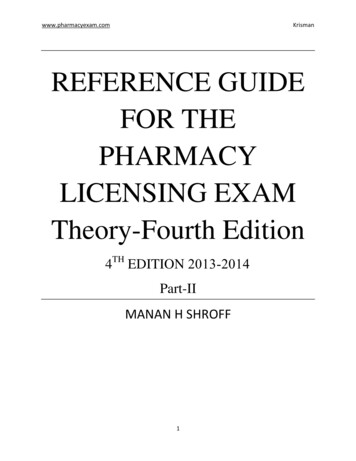
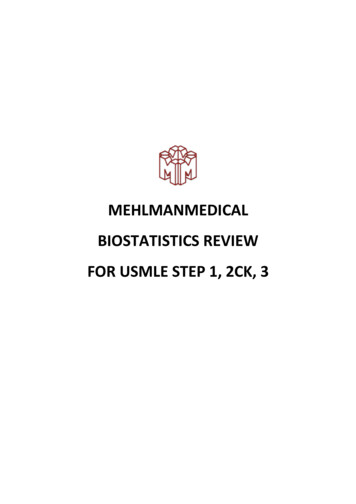
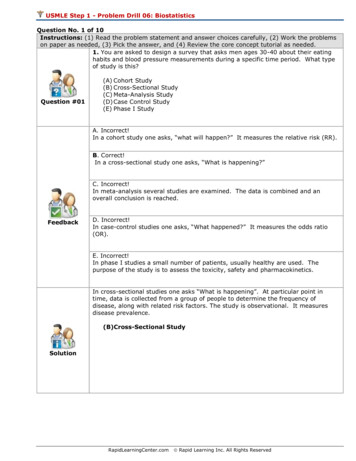
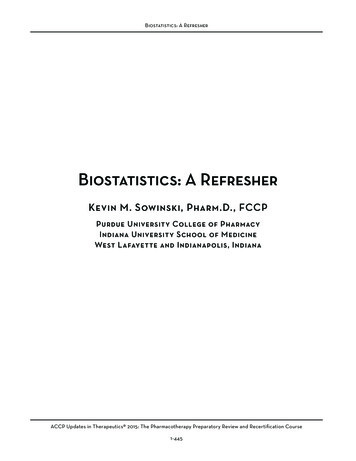
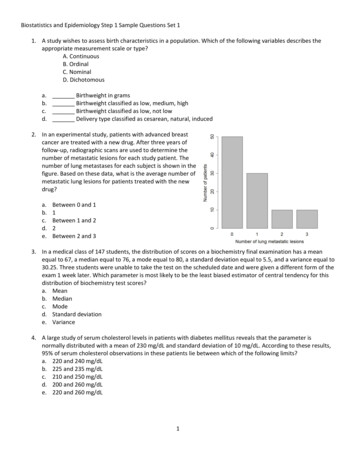
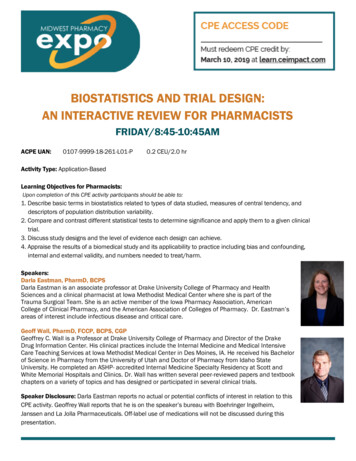
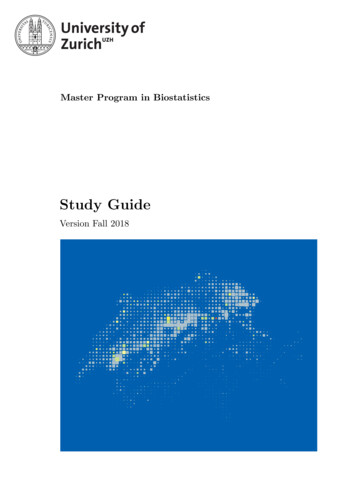
![Clinical Biostatistics [CLB]](/img/6/study-guide-clb-2021.jpg)
